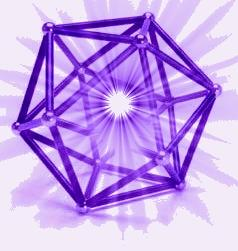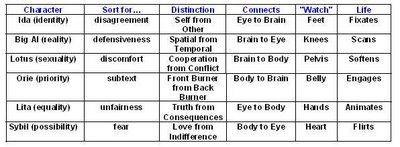Themes for November 20th to December 19th
 Although we emphasize cycle of transition in The Extended Self Program, we’re a ‘culture of destination’. Every transition has a point of departure and point of arrival. We’re social conditoned to attend to the arrival – where we end up, rather than how got there. When a transition ends, we speak of it as a ‘recovery’ of the status quo, which is now enhanced with novel experiences. During this lunar cycle, many new college students will return home after a few months away at school. They’ll return to find that their home town looks a little smaller, a little more vanilla than when they left in September. One of the cardinal signs of recovery is what’s known as jamais vu – which is when the familiar appears foreign.
Although we emphasize cycle of transition in The Extended Self Program, we’re a ‘culture of destination’. Every transition has a point of departure and point of arrival. We’re social conditoned to attend to the arrival – where we end up, rather than how got there. When a transition ends, we speak of it as a ‘recovery’ of the status quo, which is now enhanced with novel experiences. During this lunar cycle, many new college students will return home after a few months away at school. They’ll return to find that their home town looks a little smaller, a little more vanilla than when they left in September. One of the cardinal signs of recovery is what’s known as jamais vu – which is when the familiar appears foreign.Nowhere is this aspect of our self-awareness more apparent than when we detect a shift in voice mode. To be complete, we track 4 different ‘voices’ when we’re in a conversation with ourselves or others. Surprised?
1) Nonvocalized, Nonverbalized – PHYLO Voice Mode
2) Nonvocalized, Verbalized - ONTO Voice Mode
3) Vocalized, Nonverbalized – ECO Voice Mode
4) Vocalized, Verbalized – EXO Voice Mode
Society tends to focus on the verbal > nonverbal and the vocalized > nonvocalized. People, on the other hand, pick up on the way words are expressed (tonality) and how their body reacts to them (psychoacoustics). By becoming more sensitized to the voice mode of your primary domain, you can develop a resonance between your social and biological channels.
Let’s use the 4 Domains and their voice modes to migrate through a cycle of transition in the context of a conversation. Again, we’ll use the somatic interfaces to chart the journey. That 1st interface is where we begin. Here our primary domain is operating and we are within the boundary conditions of what we recognize as familiar, whether that offers us a high or low level Sense of Coherence. We are guided by our primary domain’s voice mode, using the other domains as support and a means of cross-checking things that occur close to the edge of those boundary conditions. When transition begins, that bubble is burst and we are bounced from the stable and predictable world of the 1st interface into the spiraling, dizzy one of the 2nd interface. We are now departing…
When the status quo we occupy is disturbed, the PHYLO voice mode is activated. If our primary domain is PHYLO (and for most of us, it is), when tend to not notice the drop in coherence right away since PHYLO’s are a naturally unstable crowd. Almost any stimuli will launch them into a cycle of transition. This makes sense, since PHYLO’s have the longest trip to make to fully translate their raw experience into all 4 voice modes. If a journey can be otherwise known as a quest, a conversation is launched with a question. That question is posted in a nonvocalized, nonverbalized voice mode. By that we mean that our inner voice is manisfested as bodily tension or apprehension.
That old PHYLO feeling of vulnerabilty allows our filters to open and allow more stimuli in to assess our surroundings to locate the source of this change. As this search contunues the 2nd somatic interface can be readily distinguished now and even PHYLO’s will experience the transitional state of shock. As the PHYLO voice mode intensifies, we reach a threshold where we begin to convert that nonverbalized tension into verbalized inner dialogue. This is when we have re-stabilized ourselves into the 3rd somatic interface, where we activate our coping mechanisms. The ONTO voice mode takes over here and we chain together sensations (stimuli) and feelings (responses) into an emotional schema (meaning). The moment we recognize our inner voice, we can once again manage our state, using it’s many maps. This gets us half-way.
The migration from status quo (stable) to shock (unstable) and back to coping (stable) happens in lock-step fashion. It’s hard-wired into our stress response. In general semantics, this whole section of the conversational arc is called our semantic reaction. Here’s their fast take.
[The semantic reaction] can be described as the psycho-logical reaction of a given individual to words and language and other symbols in connection with their meanings, and the psychological reactions, which become meanings and relational configurations the moment the given individual begins to analyse them or somebody else does that for him. [italics original] (S&S 4th. Ed, p. 24).
Most people are satisfied at this point. They trust their inner voice and feel secure what it is telling them is sufficient to deal with everything. But remember, this whole process began with a question. We still haven’t found the outer source of the internal dialogue. Society teaches us to resort to skip ahead to the formal language of the 5th interface. That’s where we enter into crisis and seek the support of our social relationships. And many of us lack an adequate ‘roster’ to restore order.
In fact, the opposite effect is usually seen. The more we talk at this point, the more we seek support. Eventually, we find ourselves in the 4th interface, the realm of contradiction (yes, unstable again). Now the ECO voice mode is in charge. We’re still able to speak, but the words of the old status quo are less impactful. It’s sort of like when we drive out of range of our pre-set car radio (for all those who remember terrestrial radio). We begin to get the bleeding in of other stations broadcasting on the same frequency in a neighboring town. The ECO voice mode delivers us to a space outside our old truth. We begin to learn a new dialect of it.
As the contradictions we enter the 4th interface with unravel, we begin to organize ourselves again and now we can return to the 5th interface and truly relate our new truth to others. This allows us to cross over any boundaries we had place on ourselves in the old truth’s maps. We’re almost there! Things feel more stable again and we’re sensing a return to normlacy is approaching. We can detect the runway for our point of arrival. Once we touch down though, when we return to the voice mode of our primary domain, something has changed. Unlike the 1st interface, when we were safe in our cocoon, the 6th interface is the exact opposite.
We are now completely outside our boundary conditions. There’s a feeling of fullness within from translating a seemingly random life event into a refined, time-binding form that is now freed from within us. In this way, we complete the conversational arc and the cycle of transition. In time, this new awareness will become familiar and well be right back into the 1st interface again, awaiting the bugle of the PHYLO voice mode to once again set sail on another trip through the rhythmic tides of change.
If we land in that 6th interface and notice we are in a very novel place that offers no logical chain of events back to where we started. We have not only succeeded in translating experiences using all 4 Domains. When we cannot use reason to explain our current circumstances, we have been transformed by the process of journeying through the cycle of transition. When we experience this, instead of the more conventional jamais vu, we are consumed by it’s more ECO-ish psychosocial cousin, presque vu…
In fact, the opposite effect is usually seen. The more we talk at this point, the more we seek support. Eventually, we find ourselves in the 4th interface, the realm of contradiction (yes, unstable again). Now the ECO voice mode is in charge. We’re still able to speak, but the words of the old status quo are less impactful. It’s sort of like when we drive out of range of our pre-set car radio (for all those who remember terrestrial radio). We begin to get the bleeding in of other stations broadcasting on the same frequency in a neighboring town. The ECO voice mode delivers us to a space outside our old truth. We begin to learn a new dialect of it.
As the contradictions we enter the 4th interface with unravel, we begin to organize ourselves again and now we can return to the 5th interface and truly relate our new truth to others. This allows us to cross over any boundaries we had place on ourselves in the old truth’s maps. We’re almost there! Things feel more stable again and we’re sensing a return to normlacy is approaching. We can detect the runway for our point of arrival. Once we touch down though, when we return to the voice mode of our primary domain, something has changed. Unlike the 1st interface, when we were safe in our cocoon, the 6th interface is the exact opposite.
We are now completely outside our boundary conditions. There’s a feeling of fullness within from translating a seemingly random life event into a refined, time-binding form that is now freed from within us. In this way, we complete the conversational arc and the cycle of transition. In time, this new awareness will become familiar and well be right back into the 1st interface again, awaiting the bugle of the PHYLO voice mode to once again set sail on another trip through the rhythmic tides of change.
If we land in that 6th interface and notice we are in a very novel place that offers no logical chain of events back to where we started. We have not only succeeded in translating experiences using all 4 Domains. When we cannot use reason to explain our current circumstances, we have been transformed by the process of journeying through the cycle of transition. When we experience this, instead of the more conventional jamais vu, we are consumed by it’s more ECO-ish psychosocial cousin, presque vu…
The cycle of transition only offers us it’s design. It’s up to us to develop the inner flexibility to be able to leave our primary domain and use the voice mode that best suits the interface we are experiencing life through. Although we get to use our primary domain’s voice in both the 1st and 6th interface, plus one along the road that connects them, we must actively seek out opportunities to witness our truth through other voice modes.
May you all use this last cycle of 2006 to explore your ‘unspoken’ self.
Tacitly, MRF 11.19
Further Reading…
Alfred Tomatis
Sherry Edwards http://www.soundhealthinc.com/about.html
Anacoluthian Processes: From the Greek "anacoluthon" (inconsistency in logic), a general term for system processes or methods facilitating self-organization and emergence. In these processes traditional procedures are followed while at the same time they are transgressed, thereby allowing the emergence of something radically new. An example of an anacoluthian process is the crossing-over of chromosomes from both parents in sexual reproduction. An example in a business or institution when people from diverse organizational functions are brought together in a project team, hopefully resulting in the emergence of an innovative organizational structure. http://www.plexusinstitute.org/Services/Edgeware_archive/think/main_gloss1.html



